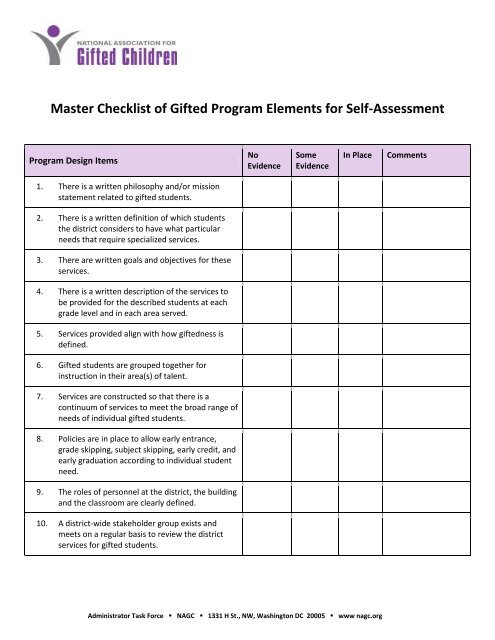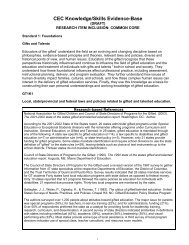Master Checklist of Gifted Program Elements for Self ... - NAGC
Master Checklist of Gifted Program Elements for Self ... - NAGC
Master Checklist of Gifted Program Elements for Self ... - NAGC
You also want an ePaper? Increase the reach of your titles
YUMPU automatically turns print PDFs into web optimized ePapers that Google loves.
<strong>Master</strong> <strong>Checklist</strong> <strong>of</strong> <strong>Gifted</strong> <strong>Program</strong> <strong>Elements</strong> <strong>for</strong> <strong>Self</strong>-Assessment<strong>Program</strong> Design ItemsNoEvidenceSomeEvidenceIn PlaceComments1. There is a written philosophy and/or missionstatement related to gifted students.2. There is a written definition <strong>of</strong> which studentsthe district considers to have what particularneeds that require specialized services.3. There are written goals and objectives <strong>for</strong> theseservices.4. There is a written description <strong>of</strong> the services tobe provided <strong>for</strong> the described students at eachgrade level and in each area served.5. Services provided align with how giftedness isdefined.6. <strong>Gifted</strong> students are grouped together <strong>for</strong>instruction in their area(s) <strong>of</strong> talent.7. Services are constructed so that there is acontinuum <strong>of</strong> services to meet the broad range <strong>of</strong>needs <strong>of</strong> individual gifted students.8. Policies are in place to allow early entrance,grade skipping, subject skipping, early credit, andearly graduation according to individual studentneed.9. The roles <strong>of</strong> personnel at the district, the buildingand the classroom are clearly defined.10. A district-wide stakeholder group exists andmeets on a regular basis to review the districtservices <strong>for</strong> gifted students.Administrator Task Force • <strong>NAGC</strong> • 1331 H St., NW, Washington DC 20005 • www nagc.org
Identification ItemsNoEvidenceSomeEvidenceIn PlaceComments11. The district uses a norm-referenced measure <strong>of</strong>ability in each <strong>of</strong> the areas <strong>for</strong> which programservices are <strong>of</strong>fered (i.e. math, language arts).12. The district uses a norm-referenced measure <strong>of</strong>achievement with adequate ceilings to assessachievement above grade level in each <strong>of</strong> theareas <strong>for</strong> which program services are <strong>of</strong>fered.13. The district uses qualitative indicators <strong>of</strong> ability toper<strong>for</strong>m in each <strong>of</strong> the areas <strong>for</strong> which programservices are <strong>of</strong>fered.14. The procedures ensure that all students have anopportunity to be nominated <strong>for</strong> screening bypublicizing the process and receiving nominationsfrom all stakeholder groups.15. Students are identified in all grade levels <strong>for</strong>which services are provided.16. The <strong>for</strong>mal identification process is repeated attargeted grade levels including (but not limitedto) kindergarten, 2 nd grade, prior to placement<strong>for</strong> middle school, and prior to placement in highschool.17. The appeals process is publicized.18. The appeals process allows <strong>for</strong> students to takealternative ability, achievement, and/orqualitative measures at no cost to the family.19. The exit procedure includes period <strong>of</strong>intervention no less than one grading period todetermine <strong>of</strong> student can be successful in theprogram with supports.Curriculum and Instruction ItemsNoEvidenceSomeEvidenceIn PlaceComments20. There is a written curriculum in core subjectareas and other areas served by the district thatis specific to students identified as gifted K-12.21. Student learning goals are clear, and evidence <strong>of</strong>how the learning will be demonstrated is clearlystated.Administrator Task Force • <strong>NAGC</strong> • 1331 H St., NW, Washington DC 20005 • www nagc.org
22. The written curriculum has clear evidence <strong>of</strong>vertical articulation from grade to grade and K-12.23. There is clear evidence <strong>of</strong> acceleration <strong>of</strong>curriculum in areas served.24. There is clear evidence <strong>of</strong> enrichment <strong>of</strong>curriculum in areas served.25. Instruction and learning experiences are clearlydifferentiated to focus on higher order thinking.26. There is evidence <strong>of</strong> teaching <strong>of</strong> communication,collaboration, research, critical thinking, problemsolving.27. The pace <strong>of</strong> instruction is appropriate <strong>for</strong> giftedstudents.28. There is evidence <strong>of</strong> student use <strong>of</strong> technology<strong>for</strong> creating content, learning content, andcommunicating content.29. Assessments are aligned to curriculum goals.30. Pre-assessment is used to determine individualinstructional plans.31. Post-assessment is used to demonstrate studentgrowth and attainment <strong>of</strong> stated learning goals.Affective Needs ItemsNoEvidenceSomeEvidenceIn PlaceComments32. A written, differentiated, affective curriculum isavailable and used by teachers that addressessocial and emotional needs <strong>of</strong> gifted students.33. Affective curriculum teaches students aboutsocial and emotional characteristics as well aspotential issues they may face.34. Documentation <strong>of</strong> differentiated collegeguidance <strong>for</strong> gifted students is available (e.g.fieldtrips, independent study projects, speakers,or shadowing experiences pertaining to collegeexploration).35. Documentation <strong>of</strong> differentiated career guidance<strong>for</strong> gifted students is available (e.g. fieldtrips,independent study projects, mentors, speakers,Administrator Task Force • <strong>NAGC</strong> • 1331 H St., NW, Washington DC 20005 • www nagc.org
or shadowing experiences pertaining to collegeexploration).Pr<strong>of</strong>essional Development ItemsNoEvidenceSomeEvidenceIn PlaceComments36. Personnel working with gifted students areprovided with opportunities <strong>for</strong> continuingpr<strong>of</strong>essional development in the area <strong>of</strong> giftededucation.37. Parents <strong>of</strong> gifted students are provided withopportunities <strong>for</strong> pr<strong>of</strong>essional developmentabout the characteristics and needs <strong>of</strong> thispopulation.<strong>Program</strong> Evaluation ItemsNoEvidenceSomeEvidenceIn PlaceComments38. The district uses multiple strategies to assessgifted student per<strong>for</strong>mance and growth.39. All components <strong>of</strong> the high ability program areperiodically reviewed by individualsknowledgeable about gifted learners and whohave competence in the evaluation process. Theresults are used <strong>for</strong> continuing programimprovement.40. The evaluation report <strong>for</strong> all educational servicesinvolving gifted students includes both strengthsand areas <strong>of</strong> challenge <strong>of</strong> the program and isaccompanied by a plan with implications <strong>for</strong>improvement and renewal over time.41. The results <strong>of</strong> the program evaluation arepresented to the local school board, thestakeholder group, and accessible to allconstituencies <strong>of</strong> the program.<strong>Checklist</strong> is taken from Neumeister, K. S., & Burney, V. (2012). <strong>Gifted</strong> program evaluation: A handbook <strong>for</strong> administrators &coordinators. Waco, TX: Prufrock Press. Used with permission <strong>of</strong> Prufrock Press.Administrator Task Force • <strong>NAGC</strong> • 1331 H St., NW, Washington DC 20005 • www nagc.org
















